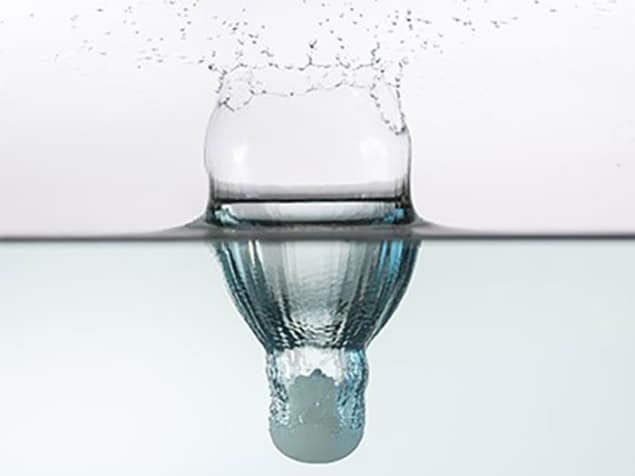
High-speed camera image of a silicone rubber sphere plunging into a tank of water. (Courtesy: Splash Lab)
A study of how deformable spheres impact on water surfaces could lead to better inflatable speedboats. The research was done by Randy Hurd, Tadd Truscott and colleagues at Utah State University, Brown University and the Naval Undersea Warfare Center Division Newport – all in the US.
The team dropped balls made of silicone rubber from three different heights (0.53, 1.53 and 2.27 m) into a tank of water. The balls had two different diameters (5.1 and 10 cm) and had three different degrees of stiffness.
Significant oscillations
The team says that this is the first study of the differences in how rigid and non-rigid materials behave when they impact water. “Rigid and elastic materials interact with the water surface quite differently,” says Hurd. “When an elastic body impacts the surface, the material deforms and oscillates significantly, which changes the water-impact physics compared to a rigid body.”
The researchers used high-speed cameras operating at 2000 frames per second to measure the position and deformation of the spheres as they enter the water (see figure). This allowed them to work out how the impact energy is absorbed by the material. They then devised a model of the deformation and vibration based the object’s stiffness and the speed of the impact.
Smoother ride
“Being able to predict water interaction from a materials perspective is an important first step in understanding which material types would be best for developing an inflatable watercraft capable of providing a smoother ride over a choppy surface,” says Hurd.
“While our work focused on answering more fundamental questions, the results could be used in the design of various structures made from deformable materials that interact with the water,” says Hurd. In addition to inflatable boats, “future applications could range from capsules to enable the deployment of sensitive equipment at sea to fly fishing.”
The study is described in the Journal of Fluid Mechanics.



